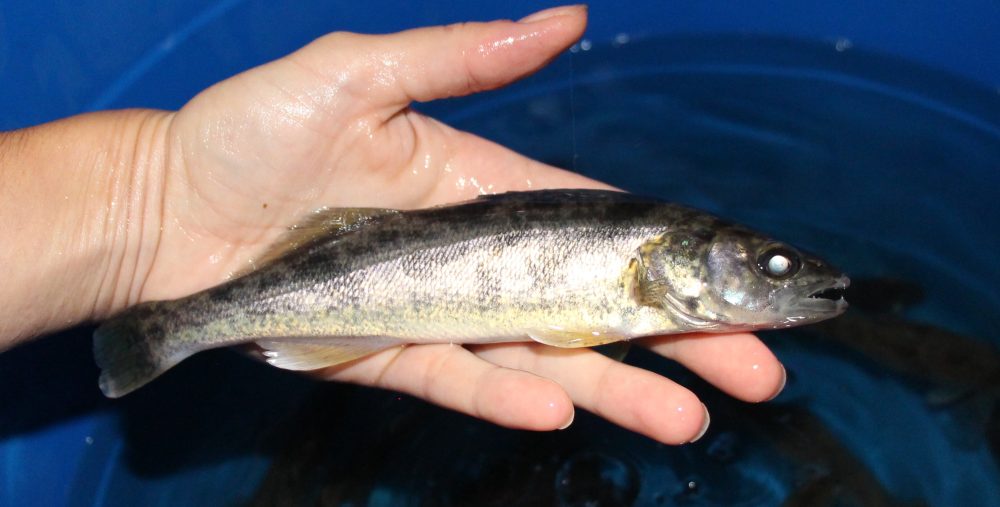Physiological and Economic Evaluation of Cold Banking Walleye Fingerlings for Year-Round Market Supply
FUNDED BY: THE NORTH CENTRAL REGIONAL AQUACULTURE CENTER
THE BACKGROUND
Walleye are one of the most valued food fish in the North Central Region. Currently, only a small aquaculture industry exists for walleye with the bulk of market supply originating from wild Canadian fisheries and imported into the United States. Because of the large demand for walleye and the high value of fillets, aquaculture production of walleye has an opportunity to find a niche. Recently, substantial research progress has made walleye a viable commercial species. Although the growth of the walleye industry is exciting, critical unknowns about how to best stagger walleye cohorts so that market-size fish are available for sale year-round (rather than once-per-year) need to be addressed.
The ability for the aquaculture industry to provide a fresh-never-frozen alternative to frozen imported fillets is likely to be an important component of walleye aquaculture’s niche. Having fresh market-size walleye available at any time of the calendar year is much more difficult than having a single harvest and freezing product. Walleye take approximately 14-18 months to reach market size, so having market sized fish available year-round requires some form of cohort staggering.
One possible approach is inducing out-of-season spawning in a captive population of walleye broodstock so that eggs are available at different points during the year. Out-of-season spawning of broodstock can be challenging with varying degrees of success. It is also highly labor intensive, requires additional space for captive broodstock, and requires costly system designs that allow for broodstocks to be kept on separate photothermal regimes. In addition, because out-of-season spawning requires intensive larviculture practices to take place multiple times each year, the costs and time investment for this approach are high. Due to these constraints, out-of-season spawning is biologically and economically challenging.
THE PROJECT
One alternative approach for cohort staggering is the use of cold banking. Cold banking involves exposing fingerling walleye to cold water temperatures to slow growth rates before bringing batches of cold banked walleye into warmer water temperatures at different times. Staggering the time at which groups of walleye are exposed to warmer temperatures allows for the growth to final market size to be staggered throughout the year.

While the cold banking approach would avoid some of the difficulties associated with out-of-season spawning, there have only been few studies that have assessed the viability of this method. Further work is needed to evaluate how early after hatching that walleye fingerlings can be cold banked (to reduce space and feed requirements) and how the costs of cold banking compare with other methods. The earlier walleye can be cold-banked (i.e. younger age), the less space and feed would be required to hold the fish. Depending on how early cold banking of walleye fingerlings can be achieved, it may be a more economical approach for staggering cohorts of walleye than utilizing out-of-season spawning.
Because the walleye food-fish aquaculture industry is in its infancy, there is currently little information available to guide best practices or demonstrate an economically viable business model. Therefore, modeling the economic feasibility of potential approaches is vitally important for facilitating the successful growth and development of the walleye aquaculture industry.
OBJECTIVES
- Evaluate various ages at which walleye fingerlings can be cold banked.
- Quantify and compare growth rates, survival rates, feed conversion, and costs of cold banking walleye fingerlings at different ages
- Use cost information from cold banking trials to compare the economic viability of cold banking relative to multiple cohorts (utilizing out-of-season spawning), and single cohort (not implementing cohort staggering methods) for producing walleye as a food fish.
- Provide feed trained fingerlings to industry partners
- Develop outreach deliverables including direct (hands on demonstration, tours, technical assistance) and indirect (presentations, publications, technical videos) targeting industry on the results of this project.
DELIVERABLES
- If successful, the research proposed by this project will demonstrate the economic and practical viability of cold banking as a cohort staggering method (Objective 1 & 2).
- Using the results of the trial, we will produce a cold banking SOP and update the Walleye Culture Guide and accompanying video series that provides practical hands-on guidance for best practices when raising walleye. If the study finds that cold banking is not an optimal approach and cannot be performed early enough during walleye grow-out to efficiently use space and minimize feed costs, then it will allow future efforts to focus more intensively on the development and optimization of out-of-season spawning as a cohort staggering method.
- Regardless of the result of the study, the proposed research will inform the development of economic models and enterprise budgets that will help prospective fish farmers evaluate and weigh the relative costs of each cohort staggering practice (Objective 3). These enterprise budgets will be made available directly on UWSP NADF website and sent directly to percid fish farmers in the region.
- Feed-trained walleye remaining at the end of the project will be donated to individual fish farmers.
PARTNERS
- The University of Wisconsin Stevens Point Northern Aquaculture Demonstration Facility
- Wisconsin Sea Grant
- Purdue University
- Aqua Garden, LLC.
- Fountain Fresh, LLC.
- Woods and Waters Fish Farm